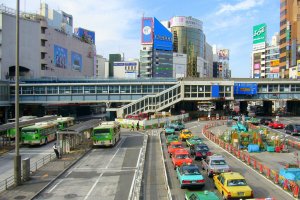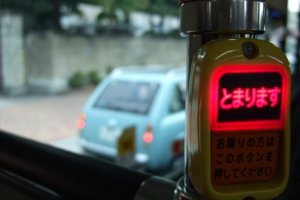Once you arrive in Japan, you will quickly realize that taking the taxi is very expensive and practically pointless unless there's an emergency or you're caught out late at night. Japan’s buses and trains are a more efficient and reasonable way to get around.
How to use the local bus
Waiting
Bus routes and schedules are posted at bus stops and arrive pretty much exactly at the times indicated on the schedule. If you know the bus times in advance, this will help minimize waiting at the bus stop.
Boarding
Board the bus from the rear door. The front door nearest the driver is used by exiting passengers (note that the opposite is true for city buses).
Either tap your IC card against the reader or pick up a paper ticket from the small ticket machine by the door if you intend to pay with cash.
Calculating your fare
It is common to see an electronic display at the front of the bus, which will indicate the next stop and a fare matrix. If you are paying by cash this is relevant to you – match up the number from your ticket to see the corresponding fare, which increases over time.
If you are using an IC card, you do not need to pay attention to this.
Disembarking
The bus will automatically announce the next stop and if you plan to get off, press one of the buttons found along the side of the bus to alert the driver you wish to disembark.

Head to the front of the bus and tap your IC card against the reader near the driver. Otherwise, put your ticket and the exact fare in the box near the driver. If you do not have the exact change, there is a machine that dispenses smaller coins.
In some areas, buses have a flat rate so you don’t have to worry about checking the fare matrix.
Note that local buses are different from long-distance highway buses (高速バス). Though these are slower than express trains, they are sometimes much cheaper and a good option if you enjoy looking out the window or don’t mind having to sleep in a moving vehicle overnight. Tickets for these have to be purchased ahead of time; there are also overnight or sleeper buses to consider.
How to use the train
Travel by train is simple and convenient. Train companies have numbered their stations and color-coded different train lines. You might see small elementary school kids in bright yellow hats taking the trains by themselves. First-time visitors with little or no Japanese language skills will quickly gain the confidence to navigate the train system after one or two uses.
Getting a ticket
If using an IC card—really, the easiest option—simply tap your card on the reader on the ticket gates and go. Otherwise, you will need to get a ticket at the ticket machines.
You can try to find your destination station and corresponding fare on the map displayed above the machines but this takes time and some stations only have Japanese maps available.
If you are stuck, there should be a support button which will request help from a station assistance. In some stations, you may find they pop out from behind the machine!
Otherwise, you may find it faster to just get the lowest possible priced ticket – you can always pay the fare difference at the other end.
Insert your ticket into the slot at the ticket gates. The ticket comes up again at the other end of the gate.
If your IC card does not have enough money, you tap your card too fast, or if your ticket is invalid, an alarm will sound and the ticket gates will blink red and close. If you encounter this problem, go to the gate with a station staff for assistance.
Find your platform, checking both train line and direction. Stand behind the yellow line, following the diagonal lines on the floor that guide people on how to line up to the door of the arriving train. Check additional information on the floor for car numbers, special reserved seat cars, and “Women Only” cars at rush hour.
When the train arrives, wait for passengers to exit before boarding. Stow your bulky bags on the overhead shelves or on the floor out of people’s way. During rush hours, expect to be crushed. Avoid using the priority seats unless you are expecting, elderly, or handicapped. Texting or surfing on your phone is acceptable but talking on your phone is frowned upon.
Approaching stations and train line connections appear on electronic screens, or if none are present, are announced. Check the station name posted on the platform. At your destination, head to the exit and tap your IC card at the ticket gate. If using a ticket (make sure to use the fare adjustment machine first if you got the lowest priced ticket and pay the difference), insert it into the slot. A single journey ticket does not pop up again so simply exit.
Travel tips
Getting an IC Card
Getting an IC card will save you a ton of time, hassle, and having to deal with a pocket full of loose change. IC cards are rechargeable cards that store money so you can just whip it out and tap it on a reader to pay for buses, trains, trams, but also at vending machines, convenience stores, fast-food chains, restaurants, and shops. In some areas, you get a slight discount in fares when you use an IC card.
IC cards are available at train stations. You will need to pay a ¥500 deposit and an initial amount charged onto it to get started. At the end of your trip, you can return the card to any train station and get your ¥500 deposit back.
There are ten major IC cards and they are valid in most of Japan’s major cities: Tokyo, Osaka, Kyoto, Nagoya, and Fukuoka. In the Greater Tokyo Area, the most commonly used IC cards are Suica (provided by JR) and PASMO. Each region has their own prepaid card and they are practically the same in coverage. The only thing to remember is that if you want to get your ¥500 deposit back at the end of the trip, you have to return the card in the region where you got it from.
With your IC card, you can go to a ticket machine and print out a receipt detailing all the stations you used and the cost, something you might want to do to remember your trip by.
Understanding the systems and knowing your alternatives
While it may seem entirely clear that subways run underground and trains above ground, it can be confusing sometimes when what was once a subway line goes above ground and becomes a different train line (e.g. the Tokyo Metro Yurakucho Line eventually becomes the Seibu Ikebukuro Line and vice versa). When you use trains managed by different companies, you incur a separate charge, which is automatically calculated upon exit, which means that sometimes, it is more expensive to travel 2 to 3 stops involving two different train companies than to travel 4 or more stops with the same company.
Note that the distances on train maps are not accurate or to scale. In some areas, it is better to walk a short distance above ground and enjoy the sights while doing so rather than trying to navigate the trains underground (for example, the beautiful palace grounds of the Marunouchi area are worth taking extra minutes to walk above ground).
Stations have been made to accommodate commuters, but at the same time it is understood that some stations are more popular than others; thus, not all trains stop at all stations. If you do not intend to spend inordinate amounts of time traveling, you will want to pay attention and make sure you are on a train that will stop at your station. Nothing is more disheartening than to see your station pass by because you got on the wrong type of train and have to backtrack.
Local trains (普通) stop at every station and take the most amount of time; use these strategically. Rapid trains (快速) skip some stations. Express trains (急行) stop at even fewer stations than rapid trains. Generally, both rapid trains and express trains do not charge extra. Limited Express trains (特急) are the fastest as they stop only at major stations but a limited express fee usually has to be paid on top of the regular fare. Look at the charts at located on the platforms to see which stations are served by what types of trains. In planning your trip, you may want to take a fast train to a major station and then change to a local train to get to your destination.
The shinkansen, or bullet train, is the fastest train available, reaching speeds of up to 320 kilometers per hour. Operated by JR, these high-speed trains connect Japan’s main islands and its major cities. Extra shinkansen fees are added to base fares in addition to special seating you may opt for. Purchasing a shinkansen ticket is easy. Machines have instructions in multiple languages and they guide you through step by step. You have the option to pay by cash, credit card, or IC card. If you get the Japan Rail Pass, the shinkansen becomes a very cost effective means of traveling the country.
Hyperdia is an English website that helps you map out your route and compare costs. It is especially popular with travelers, thanks to its English interface and flexible search options.
What to expect at train stations
Most of the time, toilets are found in the paid area of the train station so be sure to relieve yourself before you exit the ticket gates. Refrain from using multipurpose toilets unless necessary, in order to avoid the embarrassment of finding a disabled person waiting for you to finish.
Drinking fountains on the platform used to be more common in the past. In recent years, stations have been ditching fountains in favor of the more lucrative drink vending machines.
When you get to your destination station, check the exit guide and the maps posted on the walls. The wrong exit can lead you to the opposite direction of where you want to go. Exit guides usually list popular destinations in the neighborhood and the nearest exits. Stations usually have information kiosks where you can pick up brochures and maps of the locale.

























